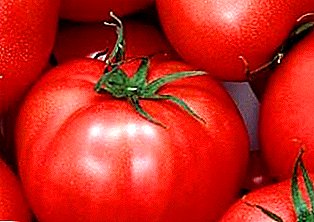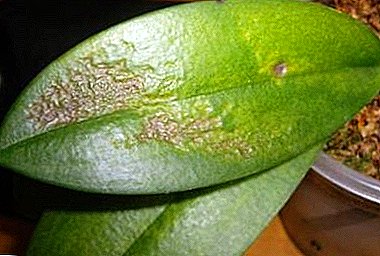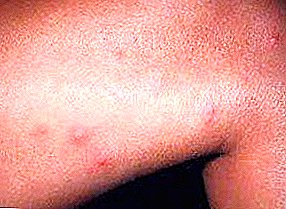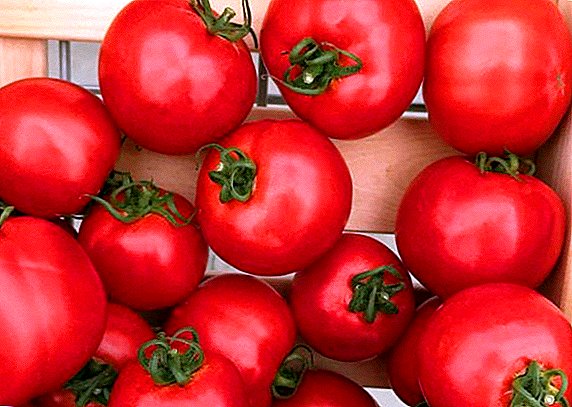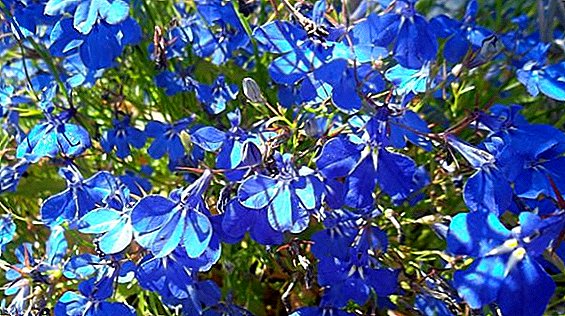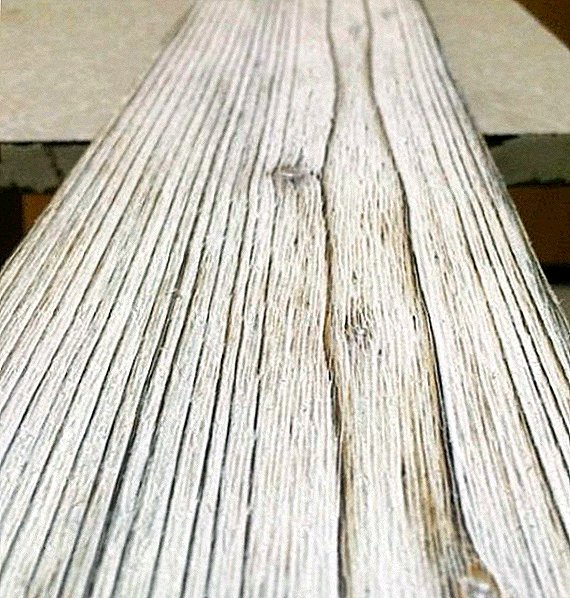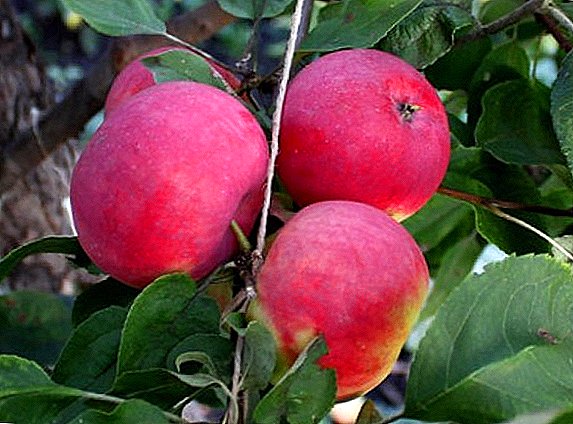 Today, the market can find a huge number of different varieties of apples, each has its own characteristics not only in cultivation, but also in the taste of the fruit. Consider what is the apple "Robin", and what features it has.
Today, the market can find a huge number of different varieties of apples, each has its own characteristics not only in cultivation, but also in the taste of the fruit. Consider what is the apple "Robin", and what features it has.
Selection
Apple "Robin" (another name - "Suislep") obtained by crossing two varieties: apple "Nedzvetsky" and "Siberian". However, most often in the literature one can find a reference to the "national selection", which means that other varieties could have participated in natural pollination. "Malinovka" is a Baltic summer variety. 
Description and distinctive features of the variety
Like other varieties, "Robin" has some differences from other species, which allow it to be identified even to beginners-lovers.
Learn more about such varieties of apples: "Candy", "Semerenko", "Orlik", "Spartan", "Bogatyr", "Currency", "Lobo", "Mantet", "Northern Synaph", "Red Chief" and " Lungwort".
Wood
The apple tree of Malinovka has the following characteristics:
- medium height (up to 5 m) with a crown in the shape of a ball or a pyramid. In diameter, it can reach 3.5 m;
- branches are thick, dark in color with a red tinge, slightly raised, with a lot of foliage;
- winter hardiness is good, it is slightly affected by scab;
- if the scion is dwarfed, the fruits appear for 4 years, on the vigorous - fruiting begins at 7 years;
- leaves are oval-shaped, dark green, medium size.

Did you know? The tree was first discovered in the second half of the 18th century in the territory of modern Estonia. Literary description found in 1845, made it French pomolog.
Fruits
The fruits ripen from late summer to early autumn and are characterized by:
- medium size, weighing up to 150 g;
- shape rounded, slightly flattened, with slight ribbing in the lower part;
- color varies from light green to yellow-green, on the sunny side color pink with red stripes;
- the skin of the fruit is thin with a waxy coating;
- the flesh is juicy, white, there are pink streaks. The apple tastes sweet and sour;
- small seeds, brown in color, are in open seed chambers;
- ripen not at the same time, prone to dropping.

How to choose seedlings when buying
Since a properly selected seedling is a pledge of a healthy tree and a good harvest in the future, it should be taken into account when choosing it:
- there should be no leaves on the planting material, if they exist, the plant is dug out early, until the sap flow has ended;
- the length of the planting specimen does not exceed 1.25 m. If it is smaller, it means that the plant was dug out ahead of time, and with a longer length, the seedling may simply not survive;
- roots must be wet, bark without damage, light brown.

Important! During transportation of purchased seedlings, the root system must be wrapped with a damp cloth and placed in a plastic bag so that the roots do not dry out.
Choosing a place on the site
Breeders are confident that the apple tree grows well in loose soil, which easily passes water and air.
The best place for planting and further care of apple seedling varieties "Robin" is:
- plot with plenty of sunshine, with fertile loose soil;
- place on high ground to avoid stagnation of water, which is detrimental to the plant. Also in the lowlands cold air stagnates, which is detrimental to both the flower and the fruit, because it sits on a tree. Well, if the place is tilted, then the cold air masses will pass through the bottom, without touching the trees;
- land further away from a fence or other obstruction that will impede air circulation.
Preparatory work
Before planting an apple tree, it is important to carry out some work that will help complete the planting process faster, and most importantly, prepare the ground for a favorable completion of the rooting of the tree. The preparatory work consists of the following stages:
- 30 days before planting, they prepare a pit for a sapling. Its size: depth up to 0.8 m and width about 1 m;
- in the middle, a previously burned stake is driven in, which protrudes above the surface of more than 60 cm;
- fertilize the soil with a composition consisting of humus, rotted mullein and organic matter. He must completely fill the pit.

Step-by-step process of planting seedlings
Planting is best done with the onset of heat, when the soil is already warm enough, but not too dry. The landing process consists of the following manipulations: 
- From the previously dug pit they take the compost, so that there is a mound in the middle. It is important to ensure that after planting the root of the tree was recessed 10 cm from the surface of the earth;
- after the desired depth has been reached, the seedling is placed in the center of the knoll and carefully spread the roots so that they lie flat on the surface;
- Now you can fill the ground, which was previously removed from the hole. Each layer is tamped and made sure that a mound forms near the tree;
- after all the roots are filled, need watering. It is important that the main part of the water was on the edge of the pit, and not near the seedling;
- when the water is almost completely absorbed, the pit with the seedling is completely covered with earth;
- after the levels become equal at a distance of 30 cm, a small ditch is dug, which will further serve as an obstacle for water flow during irrigation;
- at the end, the tree is tied to a support and another 20 liters of water is poured into the ditch.
 When planting several trees, the distance between them should be at least 4 m.
When planting several trees, the distance between them should be at least 4 m.Important! The stick, which will serve as a support for the smooth growth of the tree, should be on the north side of it.
Seasonal care features
To get a rich harvest of apples, seasonal work must include:
- soil care;
- timely feeding;
- preventive work;
- pruning and winterizing.
Soil care
The watering procedure needs special attention, since the maximum fertility of a tree can be achieved only if it is correctly performed. The best option - watering at the root. On very hot days, watering should be abundant. After performing this procedure, it is important not to forget to loosen the soil to ensure the air to the roots. To reduce the evaporation of moisture is recommended to carry out mulching, this is suitable for any available inorganic or organic material. It is laid out in a small layer on the surface of the earth. 
Top dressing
In the first years of life, fertilizing is carried out several times throughout the year. Under the root make a mixture of organic and mineral fertilizers. Most often, feeding is carried out in the following time:
- the first time they fertilize the land at the end of April, scattering around a tree 0.5 kg of urea or several buckets of ordinary manure;
- the next time feed up at the stage of formation of colors. Liquid fertilizers are applied, which include potassium sulphate, urea and superphosphate;
- during the pouring of the fruit is fertilized with a solution of nitrophoska with the addition of sodium humate;
- the last feeding is carried out after harvesting. This is done with the help of potassium sulfate and superphosphate, which is diluted in water and watered with the resulting composition of the earth.
 After reaching 3 years old, feed up once a year.
After reaching 3 years old, feed up once a year.Preventive treatment
To obtain a high-quality harvest, it is necessary to carry out preventive work from pests and various diseases throughout the season. Apple trees and fungicides are sprayed on a bare tree and a pink bud, and before the onset of winter, the trunks are whitened and the wounds are painted over with iron red lead. 
Did you know? The word "apple" is so ancient that it is impossible to establish the accuracy of its origin. It is known that in antiquity all the fruits of round-shaped trees were called apples.
Pruning
Remove excess or broken branches in early spring. Make such manipulations with a sharp shears or other special tools available. One year after planting, before the juice begins to move, branches are cut out that prevent the crown from forming correctly. On average, it is formed over 6 years. Experts believe that the earlier pruning, the more time the tree will have to restore and replenish forces for later fruiting.
Learn how to properly prune apple trees in the fall and spring.

Protection against cold and rodents
Fruiting next year depends directly on how well the tree is protected in the cold season. You can cover the trunk using old bags or agrofibre. Immediately after the snow falls, you need to use it to create a snow cushion around the bottom of the trunk.  Today, to protect themselves from rodents, carry out the following work:
Today, to protect themselves from rodents, carry out the following work:
- bleaching the trunk from the roots to skeletal branches, using acrylic paint for the garden;
- scatter the poison near the burrows of animals in the area;
- place objects on the trees that create noise;
- envelop the lower part of the trunk with a special film.
Knowing the description of the sort of apple "Robin", as well as the characteristics of its planting and cultivation, you should not have problems with the new inhabitants of your garden.


